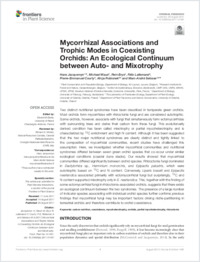Mycorrhizal associations and trophic modes in coexisting orchids: an ecological continuum between auto- and mixotrophy
- Jacquemyn, Hans Plant Conservation and Population Biology, Department of Biology, Leuven, Belgium
- Waud, Michael Plant Conservation and Population Biology, Department of Biology, Leuven, Belgium
- Brys, Rein Research Institute for Forest and Nature, Geraardsbergen, Belgium
- Lallemand, Félix Institut de Systématique, Évolution, Biodiversité, Muséum National d’Histoire Naturelle, Sorbonne Universités, Paris, France
- Courty, Pierre-Emmanuel Department of Biology, University of Fribourg, Switzerland
- Robionek, Alicja The Laboratory of Freshwater Ecology, Department of Plant Ecology, University of Gdañsk, Poland - Department of Plant Taxonomy and Nature Conservation, University of Gdañsk, Poland
- Selosse, Marc-André Institut de Systématique, Évolution, Biodiversité, Muséum National d’Histoire Naturelle, Sorbonne Universités, Paris, France - Department of Plant Taxonomy and Nature Conservation, University of Gdañsk, Poland
-
2017
Published in:
- Frontiers in Plant Science. - 2017, vol. 8, p. 1497
English
Two distinct nutritional syndromes have been described in temperate green orchids. Most orchids form mycorrhizas with rhizoctonia fungi and are considered autotrophic. Some orchids, however, associate with fungi that simultaneously form ectomycorrhizas with surrounding trees and derive their carbon from these fungi. This evolutionarily derived condition has been called mixotrophy or partial mycoheterotrophy and is characterized by 13C enrichment and high N content. Although it has been suggested that the two major nutritional syndromes are clearly distinct and tightly linked to the composition of mycorrhizal communities, recent studies have challenged this assumption. Here, we investigated whether mycorrhizal communities and nutritional syndromes differed between seven green orchid species that co-occur under similar ecological conditions (coastal dune slacks). Our results showed that mycorrhizal communities differed significantly between orchid species. Rhizoctonia fungi dominated in Dactylorhiza sp., Herminium monorchis, and Epipactis palustris, which were autotrophic based on 13C and N content. Conversely, Liparis loeselii and Epipactis neerlandica associated primarily with ectomycorrhizal fungi but surprisingly, 13C and N content supported mixotrophy only in E. neerlandica. This, together with the finding of some ectomycorrhizal fungi in rhizoctonia-associated orchids, suggests that there exists an ecological continuum between the two syndromes. The presence of a large number of indicator species associating with individual orchid species further confirms previous findings that mycorrhizal fungi may be important factors driving niche-partitioning in terrestrial orchids and therefore contribute to orchid coexistence.
- Faculty
- Faculté des sciences et de médecine
- Department
- Département de Biologie
- Language
-
- English
- Classification
- Biological sciences
- License
-
License undefined
- Identifiers
-
- RERO DOC 305605
- DOI 10.3389/fpls.2017.01497
- Persistent URL
- https://folia.unifr.ch/unifr/documents/305906
Statistics
Document views: 92
File downloads:
- pdf: 226
